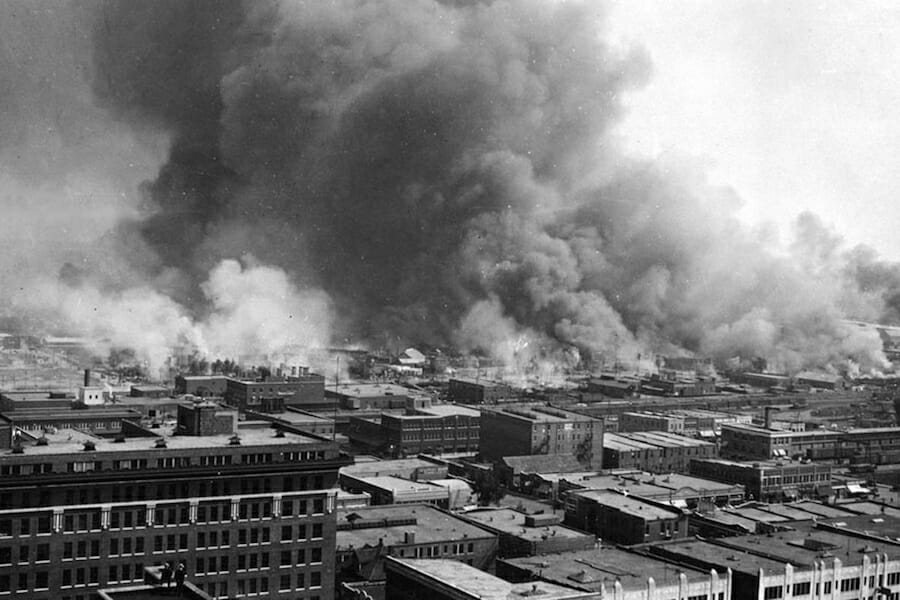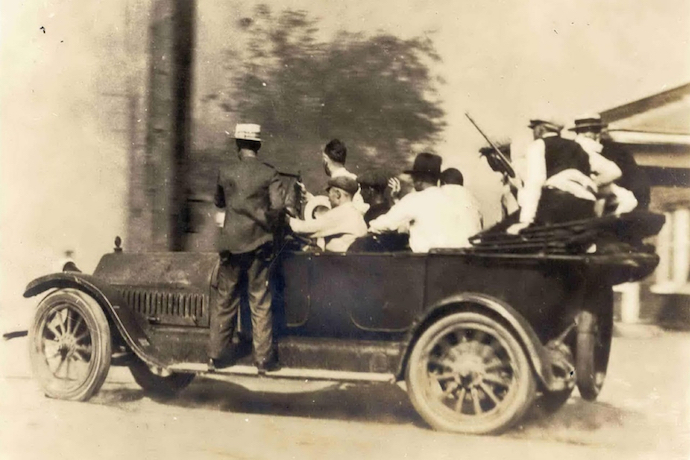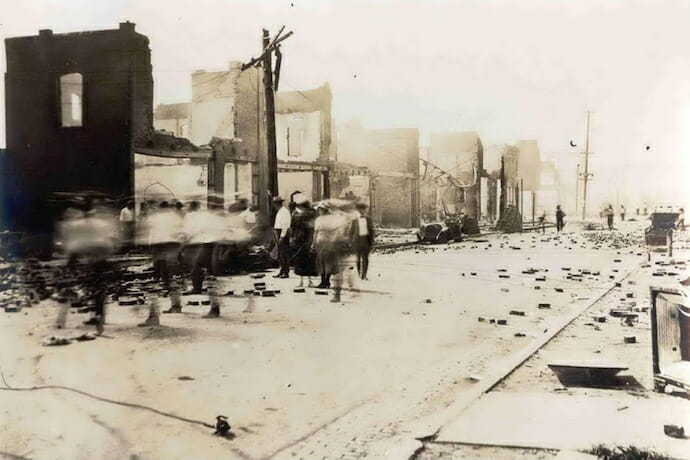
Untold History: Black Wall Street and the Tulsa Race Riots
Greenwood, Oklahoma was known as the Mecca for black enterprise. It was a district featuring 108 black-owned businesses, two theaters, two black schools and 15 doctors’ offices. With Tulsa being segregated by north and south, there was only one place you could go if you were black and wanted to establish a name for yourself. For many, that safe haven was Greenwood. It became so prestigious that Booker T. Washington coined the term “Negro Wall Street of America.”
On May 31st, 1921, Greenwood was destroyed. 50 square blocks were decimated, burned to the ground by angry white mobs. Many homes and businesses were looted in one of America’s worst race riots. The cause: white outrage over a false sexual assault allegation.
Oklahoma had developed a considerable history for the African American population. In the 1830s it became a place of refuge for many minority groups. During the Westward Expansion, much of the American frontier was up for settlement. Many Native American tribes, including Seminoles and Cherokees, were forced to migrate from their homes in the Southeast during the Trail of Tears. They settled in what was called the Indian Territory, comprising modern-day Oklahoma. Many African Americans accompanied them as slaves.
After the Civil War, the Indian Territory was divided into two halves: one half Oklahoma, and the other remaining the Indian Territory. In 1889, President Harrison opened the Oklahoma Territory to new settlement due to pressure from white settlers.
Within a day, 2 million acres were claimed for 50,000 settlers in a homestead race. Many blacks were among them as cowboys, cattle ranchers and farmers. By 1900, the black population in the region was 55,000. It was even proposed by Edwin McCabe, the former state auditor of Kansas, that Oklahoma become the first all-black state.

By 1907, 27 all-black towns were created in Oklahoma. After its statehood, the same year, the first bill established segregation in its territory. After the Ida Glenn oil range was discovered, earlier in 1905, Tulsa experienced a population boom. The range brought in lucrative profits and established Tulsa as the “oil capital of the world.”
However, the wealth of this went mainly to white business owners, with blacks receiving small, trickle-down benefits. Because of segregation laws, Tulsa was divided between black populations living in the north end, and white populations living in the south end. Blacks predominately worked in south Tulsa for their white bosses.
As a result, many young black entrepreneurs started to create a business district in one of their neighborhoods, Greenwood. Its first business was a grocery store; then came theatres, dance halls, poolrooms and shine parlors, all of which were black-owned.
Tragically, the success of Black Wall Street would not outlast the turbulence of America’s race problem. Throughout the US, there was an explosion of race riots, in places like Minnesota, Nebraska, Pennsylvania and Chicago. These riots were characterized by an invasion of black communities, often aided by police.
The Tulsa riot all started with Dick Rowland, a 19 year-old black man who had dropped out of school to make money as a shoe shiner in white, downtown Tulsa. Because of segregation laws, only one restroom was open to blacks, on the upper floor of the downtown Drexel building. The elevator was operated by a white woman, Sarah Page. One day Rowland tried to get on and tripped, grabbing onto the woman. She screamed and Rowland fled the elevator, only to be witnessed by a white store clerk who reported the incident to police as an assault. Rowland was arrested and jailed, and a news article highly implied that he had attempted to rape the elevator operator.
After a crowd of angry whites gathered outside the courthouse where Rowland was held, the Tulsa sheriff ordered armed guards to protect it. The Greenwood community decided to take matters into their own hands. A group of armed blacks rushed to the courthouse to defend the jail. They later returned home after the sheriff assured them that it would be protected. The whites of south Tulsa armed themselves in retaliation, numbering up to 2,000.

The group of armed blacks returned to the courthouse and was once more turned away. Only this time there was an altercation between one of the black mob and one of the white mob. It ended with shots fired. Then, the riot exploded.
The white rioters invaded the black Greenwood district, attacking. Many gun battles went off in the streets and even the police joined the white rioters. Homes and businesses were burned to the ground, forcing families to flee.
The violence escalated to the point where the National Guard was sent in. Martial law was declared in Tulsa. Troops rounded up blacks in large numbers and took them to internment centers. The white rioters were only disarmed.
According to estimates, at least 300 people died in the Tulsa race riots, 10,000 were left homeless and more than 1,000 homes and businesses were destroyed. It has even been reported, recently, that private airplanes were used to drop kerosene bombs on houses. White men in places, performing “Negro reconnaissance” missions, were seen shooting at blacks on the ground. By the end of the chaos, 50 square blocks were completely decimated. Black Wall Street was destroyed.
After being released from prisons and internment camps, blacks were required to wear green tags wherever they went, as identification marks. Many were forced to live in tent cities, where the Red Cross came to assist them with food and medicine.
The local government established a reconstruction committee, but this was only used to try and seize more black lands for industrial purposes. A fire ordinance providing tough construction requirements made rebuilding Greenwood all but impossible.
A black lawyer named BC Franklin set up a law office in one of the tents and proceeded to challenge the ordinance with its stringent requirements. The Oklahoma Supreme Court later struck it down, allowing Greenwood residents to rebuild Tulsa.
The white mob never paid its price for destroying Tulsa. A state grand jury placed the blame for the conflict on “black agitators.” None of the whites were sentenced to prison. The elevator assault allegation, however, never proceeded to trial. Dick Rowland was let off: a surprising outcome for the time.
Much of Greenwood has been rebuilt over time, including a Mount Zion Baptist church. However, desegregation did destroy the prospect of re-establishing a business district in Black Tulsa, as many blacks spent their money elsewhere and patronized white-owned establishments. Black Wall Street never returned

